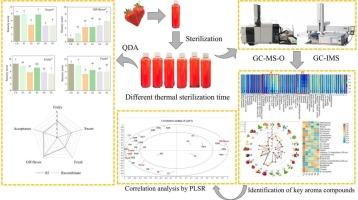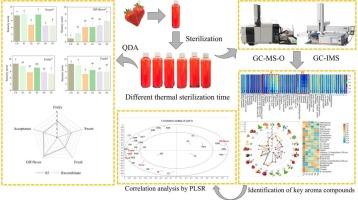热灭菌草莓汁中异味形成的机制:来自GC-IMS、多元统计和感知学的见解
IF 9.8
1区 农林科学
Q1 CHEMISTRY, APPLIED
引用次数: 0
摘要
热灭菌过程中草莓汁独特香气的异化理论基础尚不充分。本研究采用气相色谱-离子迁移谱法(GC-IMS)、气相色谱-质谱-嗅觉法(GC-MS-O)和气味活性值(OAV)计算方法,分析了6种草莓汁经过不同热灭菌时间后的香气特征。共有18种关键的芳香活性化合物被确定为草莓汁特色风味的贡献者。其中,己酸乙酯、r-γ-癸内酯、(E)-2-辛醛和庚醛经热杀菌后分别下降了28 %、29 %、100 %和100 %,导致鲜味和果味属性减弱。此外,通过偏最小二乘回归(PLSR)、香气重组和遗漏实验,确认三硫二甲基(3.61 μg/kg)、(E)-3-己烯醇(12.54 μg/kg)和己酸(106.15 μg/kg)是热杀菌过程中产生异味的主要原因。这些发现为研究热灭菌草莓汁中异味物质的形成途径提供了基础。本文章由计算机程序翻译,如有差异,请以英文原文为准。


Mechanisms of off-flavor formation in thermally sterilized strawberry juices: Insights from GC-IMS, multivariate statistics, and sensomics
The theoretical basis for dissimilating distinctive aroma profile of strawberry juice during thermal sterilization remains insufficient. In this study, the aroma profiles of 6 strawberry juice subjected to different thermal sterilization times were analyzed using gas chromatography-ion mobility spectrometry (GC-IMS), gas chromatography–mass spectrometry-olfactometry (GC–MS-O) and odor activity value (OAV) calculation. A total of 18 key aroma-active compounds were determined as contributors to the characteristic flavors of strawberry juice. Among these, ethyl hexanoate, r-γ-decalactone, (E)-2-octenal, and heptanal decreased by 28 %, 29 %, 100 %, and 100 % respectively after thermal sterilization, causing the weakening of fresh and fruity attributes. Additionally, dimethyl trisulfide (3.61 μg/kg), (E)-3-hexenol (12.54 μg/kg), and hexanoic acid (106.15 μg/kg) were confirmed as major responsible for the generation of off-flavors during thermal sterilization, through partial least squares regression (PLSR), aroma recombination, and omission experiments. These findings provide foundation for researching the formation pathways of off-flavor compounds in thermally sterilized strawberry juice.
求助全文
通过发布文献求助,成功后即可免费获取论文全文。
去求助
来源期刊

Food Chemistry
工程技术-食品科技
CiteScore
16.30
自引率
10.20%
发文量
3130
审稿时长
122 days
期刊介绍:
Food Chemistry publishes original research papers dealing with the advancement of the chemistry and biochemistry of foods or the analytical methods/ approach used. All papers should focus on the novelty of the research carried out.
 求助内容:
求助内容: 应助结果提醒方式:
应助结果提醒方式:


